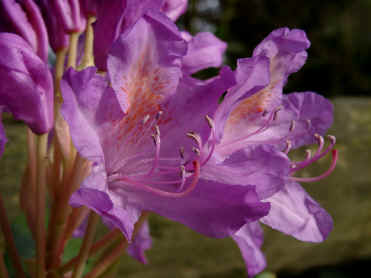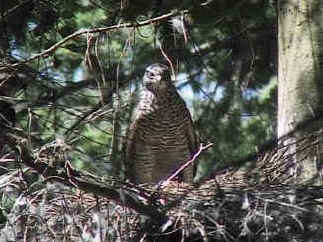Woodlands &
Biodiversity (2)
Native versus non-native species

Woodland biodiversity is affected by whether the tree species making up the woodland are native (such as the Oak above) or introduced species. Introduced species usually support far fewer invertebrates than native species.
Coniferous woodlands tend to have lower biodiversity than broadleaf woodlands. This is partly because they are usually predominantly composed of introduced species. Management practices designed to reduce pests and competition from other plants also reduce biodiversity. However, coniferous woodlands still have considerable biodiversity value because they often contain a range of different species to those found in broadleaf woodlands.
| Woodland biodiversity is affected not only by
available light, but also by whether the main tree species making up the woodland are
native to Britain or not. Tree species introduced from other countries are often
unpalatable to native species of invertebrates, which have not evolved to feed on them.
Thus in a native Oak woodland, you have the possibility of finding 284 different insect
species scattered over individual oak trees. A similar search of introduced Horse Chestnut
trees, would yield only 4 different insect species. Table showing The Value of Different Tree Species for Invertebrates and Lichens Rhododendron, which is an understorey species, is an extreme case which illustrates how introduced plant species can affect overall biodiversity in an area.
Coniferous woodlands tend to have a lower biodiversity than broadleaf woodlands. This is partly due to the fact that most coniferous woods in England are plantations of non-native tree species, which have been introduced to improve timber yields. Thus, the introduced Spruce and Larch species, have 37 and 17 insect species associated with them respectively. In contrast, the native Scots Pine has 91 associated insect species (Table). The area of Scots Pine plantations in Britain is far outweighed by the planted area of introduced conifers. Scots Pine tends to be grown in the less hospitable areas for forestry because it is better adapted to the local environmental conditions. While native Scots Pine plantations may naturally have higher insect biodiversity, this can be detrimental to forestry. Many of the insects present are likely to be viewed as pests, rather than as a desirable extra. Large numbers feeding on the trees may result in losses in tree growth and damage to timber. The management involved in coniferous forests, whether of native or introduced species, also results in lower biodiversity for a number of reasons. Plant species which would compete with the trees, are either removed altogether or discouraged from growing. The resultant reduction in native understorey and field layer plant species, greatly reduces plant diversity. Along with the reduction in plant diversity, there will also be a reduction in animal diversity. In addition, the trees are a crop, so that the wood produced is harvested and removed from the area. Few, if any, of the trees die a natural death and their wood is not recycled through the normal wood-rotting system of a natural woodland. There is therefore much less in the way of rotting wood for the many species of invertebrates and fungi which inhabit this type of microhabitat.
Vertebrate species such as birds and mammals tend to be less affected by the specific varieties of plants in a habitat and more by the actual structure of the habitat. For example, the birds will usually be more concerned with the height of the vegetation, the underlying layered structure of the wood and the variety of microhabitats available. Birds and mammals are often also less specific in their eating habits than invertebrates and may consume a wide variety of foods. In contrast, a herbivorous insect may require the presence of very specific plant species on which to feed.
|
Continue to Structural Diversity
Woodlands & Biodiversity Contents

